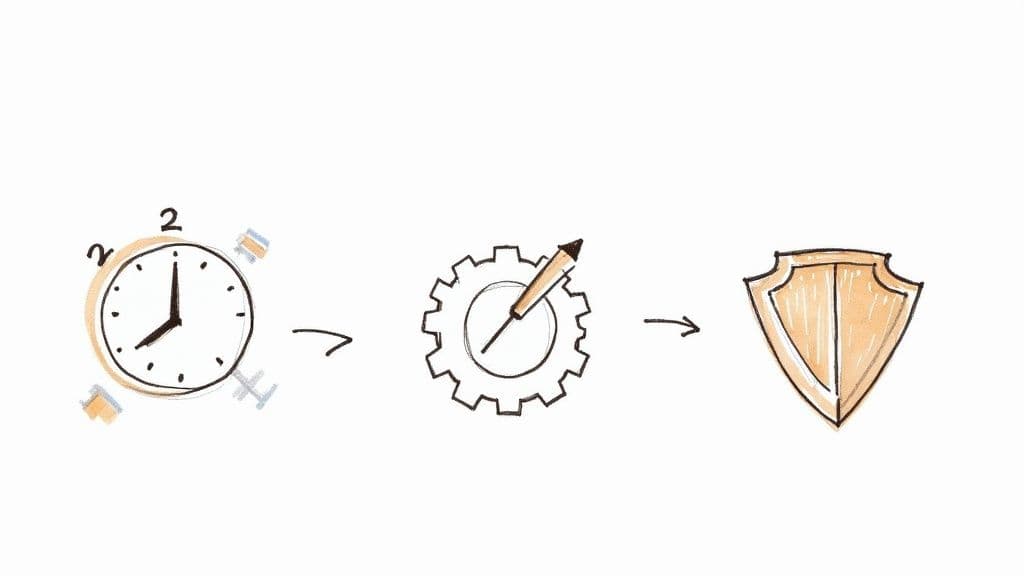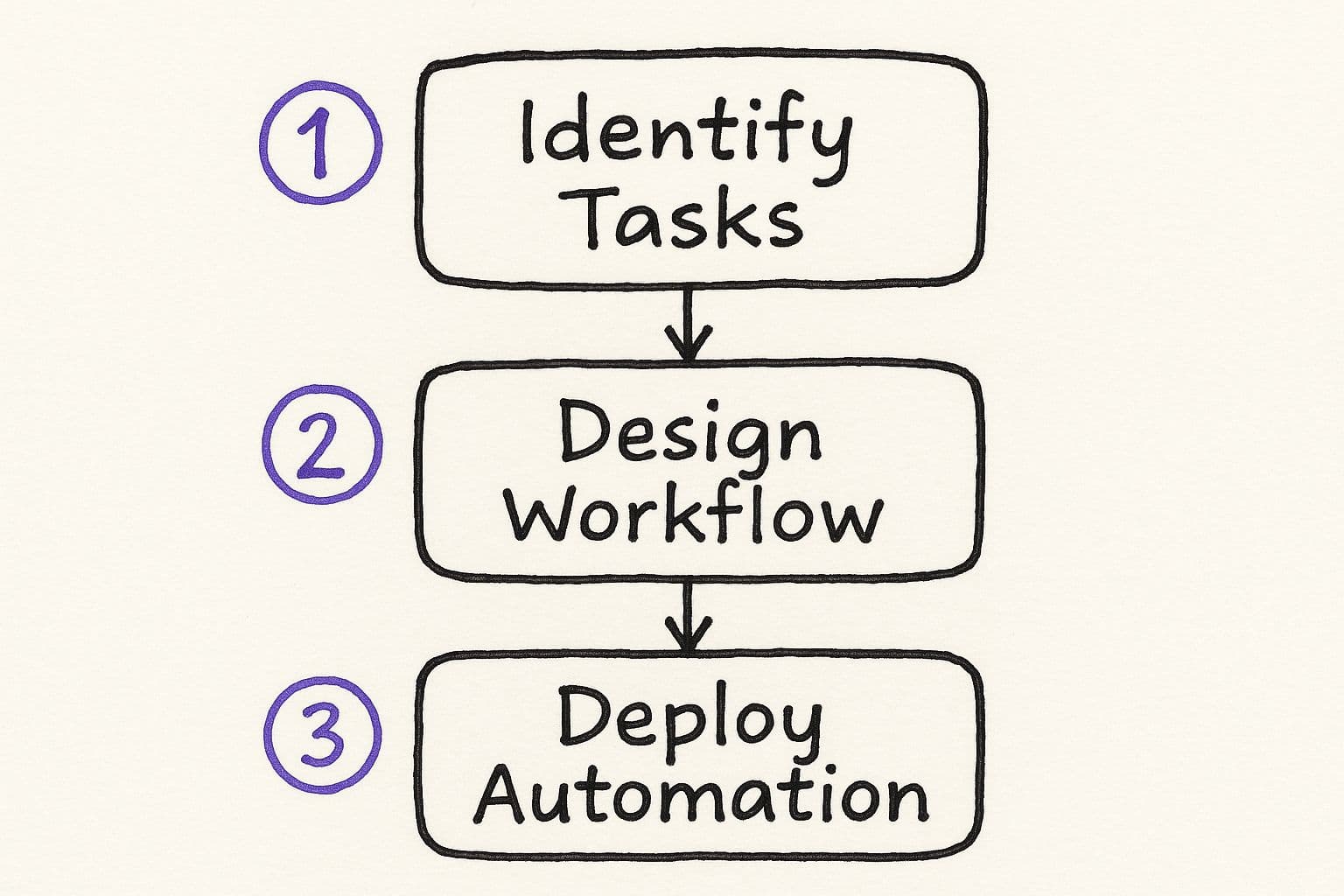Business process automation (or BPA) isn't just a tech buzzword.
Think of it this way: BPA is about teaching technology to handle the repetitive, mind-numbing tasks that currently eat up your team's time. It’s about building a smarter, error-proof system so your people can focus on the work that actually grows the business.
Why Automation Is a Game-Changer for UK Businesses
Let's be honest. When you hear "business process automation," it's easy to picture a massive, complex system only a giant corporation could afford. That’s just not the reality anymore.
This isn't about replacing your team with robots. It’s about giving them superpowers by taking away the boring stuff.
Picture your finance team slogging through hundreds of invoices every month. Each one is a minefield of manual data entry, cross-checking, and chasing approvals. A single typo can lead to a delayed payment or a compliance headache. It’s slow, tedious, and risky.
Now, imagine BPA handling that. It automatically pulls the data from an invoice, checks it against the purchase order, and sends it for digital approval. Zero manual keying. Zero human error. That's the difference.
The Real Benefits (It’s Not Just About Saving Time)
Everyone focuses on saving time, and sure, that’s a huge win. But the real magic of business process automation happens when it fixes the operational weak spots that quietly drain your resources.
- Slash Human Error: Manual data entry is a recipe for mistakes. We've all been there. Automating these tasks guarantees consistency and accuracy—critical for everything from your financial reports to your customer database.
- Make Compliance and Audits Easy: If you're in a regulated industry, you know the pain of audit trails. Automation creates a perfect, digital log of every single action. Proving compliance becomes a simple report-pull, not a frantic paper chase.
- Happier, More Engaged Team: Nobody loves spending their day copying and pasting. When you free your team from monotonous work, they can tackle bigger challenges, think strategically, and solve real problems. That's a direct path to better job satisfaction and lower staff turnover.
This isn’t just a niche trend; it’s a major shift in how UK businesses operate. The UK’s process automation market hit a value of around USD 6.72 billion in 2024, and it’s still climbing fast. This shows that operational efficiency isn’t just a nice-to-have anymore; it's a core strategy for staying competitive. You can read more about these market projections if you want to see the full picture.
To make this practical, let's look at the before-and-after of bringing automation into your daily grind.
From Manual Grind to Automated Flow: A Practical Comparison
This table breaks down how common, frustrating manual tasks transform into smooth, automated workflows, highlighting the direct wins for your business.
| Manual Task | Automated Process | Primary Benefit |
|---|---|---|
| Data Entry from Invoices | AI-powered data extraction and validation. | 99%+ accuracy, reduced payment cycles. |
| New Employee Onboarding | Triggered workflow for IT setup, HR docs, and training access. | Day-one productivity, consistent experience. |
| Customer Support Tickets | Automatic routing of queries to the right department. | Faster response times, higher customer satisfaction. |
| Generating Weekly Reports | Scheduled data pulls and report generation sent via email. | Zero time wasted, consistent data for decisions. |
| Chasing Unpaid Invoices | Automated email reminders sent at set intervals. | Improved cash flow, less admin overhead. |
Seeing it laid out like this makes the value pretty clear. It's a direct upgrade from time-consuming, error-prone work to efficient, reliable systems that run themselves.
By automating these rule-based tasks, you're not just making things faster. You're making them fundamentally more reliable. That reliability builds trust—with your clients, your partners, and your own team—creating a rock-solid foundation for growth.
To really nail this down and get your team on board, you need to connect the dots to the bottom line. It's one thing to say automation saves time; it's another to show it saves £10,000 a quarter.
Using a tool like an automation ROI calculator can be a game-changer here. It helps you turn abstract benefits into a concrete business case, showing exactly how much money and how many hours you’ll get back. That clarity is what you need to justify the investment and decide which processes to tackle first.
Finding the Right Processes to Automate

48fab64d-4b7f-49ae-a266-1c4b578dcacc.jpg
Here’s the biggest mistake you can make with business process automation: picking the wrong target.
Seriously. Trying to automate a broken or chaotic process doesn’t fix anything. It just makes the chaos happen faster. Real success starts with an honest look at your current workflows to find the genuine opportunities.
Think of it as looking for tasks with a specific DNA. The best candidates for automation are almost always the jobs that nobody on your team enjoys. They're the repetitive, mind-numbing tasks that kill creativity and drain energy.
Spotting Automation Goldmines
So, what should you be looking for? The signs are usually pretty obvious once you know where to focus. A process is ripe for automation if it’s predictable and follows a set of established rules every single time.
You’ve hit an automation goldmine if the task is:
- High Volume and Repetitive: Is it something someone does over and over, every single day or week? Think about processing new member sign-ups, sending welcome emails, or pulling weekly finance reports.
- Rule-Based: Does it follow a simple 'if this, then that' logic? For example, if a member's payment fails, then an email is automatically sent. There's no subjective judgement needed here.
- Prone to Human Error: Tasks that involve manually typing in data or copying info between different systems are classic sources of mistakes. One typo in an email address or payment amount can spiral into a huge headache.
- Time-Sensitive: Many things, like revoking access after a cancelled subscription, need to happen immediately. Automation guarantees these actions are performed on time, every time, without fail.
The goal isn't just to do things faster, but to build a more resilient operation. By identifying and automating these error-prone, repetitive tasks, you're not just saving hours; you're removing potential points of failure from your business.
From Theory to Practice
Let's ground this in the real world. A creator using MyMembers for their private Telegram community deals with a constant flow of new subscribers. Manually sending a welcome message, adding their details to a spreadsheet, and setting a reminder for their renewal date is the perfect storm of repetitive, rule-based work.
Automating this means as soon as a payment is confirmed via Stripe, MyMembers instantly sends the invite, adds them to the community, and logs the data. No human intervention needed. That's a prime example of business process automation in action.
To justify the effort, you need to map out the financial return. A great first step is figuring out the lifetime value of your members. Understanding what each member is worth helps you see the direct financial impact of retaining them through better, automated experiences. You can learn how to do this with our guide on determining your lifetime value calculator. This data gives you a solid foundation for making smart decisions about where to invest your automation efforts for the biggest impact.
Right, let's stop talking theory and get our hands dirty. Diving into business process automation can feel like a massive task, but your first workflow is way simpler to set up than you'd think. We’re going to build something that delivers real value, right now.
The best place to start? A common, high-impact job. For most creators I know using MyMembers, that’s the new member welcome sequence. It’s the perfect guinea pig: repetitive, rules-based, and absolutely critical for making a great first impression.
Getting Started with MyMembers
First things first, you need to make sure your MyMembers account can talk to your other essential tools. This usually means linking your Stripe account for payments and your email service provider, like Mailchimp or ConvertKit. Think of these integrations as the bridges that let data flow between your systems. They're the backbone of any good automation.
With your apps connected, it's time to build the workflow. I like to think of it as a set of dominoes. The "trigger" is the first domino to fall—in this scenario, a successful new subscription payment through Stripe. That one event kicks off a whole chain of automated "actions."
An effective automation doesn't just do one thing; it orchestrates a sequence of related tasks. The goal is to create a seamless experience for your new member while completely removing the administrative burden from your plate.
Here’s what that first chain reaction could look like inside MyMembers:
- Trigger: A new member successfully subscribes.
- Action 1: MyMembers automatically pings them an invitation link to your private Telegram group.
- Action 2: Their details (name and email) are instantly added to a specific "New Members" list in your email platform.
- Action 3: Your email platform gets the signal to send the very first email in your pre-written welcome series.
This sketch visualises the whole process, from figuring out the task to hitting the 'go live' button on the automation.

1ae26185-840d-480e-a7f4-c7388c0afcb9.jpg
This simple flow proves that good automation is just a logical sequence of clear, defined steps. No magic, just logic.
Testing and Launching Your Workflow
Before you unleash this on real members, you have to test it. It's non-negotiable. Most platforms, MyMembers included, have a testing mode. Run a test payment and watch the dominoes fall. Did the Telegram invite actually send? Was the contact added to the right email list? Did the welcome email land in the inbox?
Once you’ve confirmed every step fires exactly as it should, you can flip the switch and activate the workflow. And just like that, you’ve built your first piece of business process automation.
Getting this first win under your belt is huge. While we’ve focused on a marketing example here, the same thinking applies everywhere. The UK’s industrial process automation market, for example, was valued at USD 4.76 billion in 2023 and is rocketing upwards. That shows a massive shift towards automating everything from factory floors to stock management.
For a deeper look into the nitty-gritty of setting up these kinds of workflows, including some great strategies for a successful launch, I'd recommend checking out a solid marketing automation implementation guide. Building on this first success gives you the confidence to start tackling much bigger, more complex processes.
Scaling Your Automation For Maximum Impact

132399fc-e4c5-4289-8232-1b82495b47b5.jpg
Getting your first automation live is a huge win. But it’s just the start. The real magic happens when you move from automating single tasks to building an interconnected system that grows with your business.
Think of it like this: your first workflow is a solo instrument. Maybe a reliable drumbeat, steady and effective. Scaling is when you bring in the whole orchestra. You start connecting different apps and processes to create something truly powerful. This is where you see the biggest returns.
Monitoring and Refining Your Workflows
An automation isn't a "set it and forget it" machine. You need to keep an eye on it to make sure it’s still doing the job you built it for. The goal is to spot any bottlenecks or areas for improvement before they become actual problems.
I always start by asking a few simple questions:
- Is it actually running? A quick check of the logs in a tool like MyMembers will show any errors or failed runs. Don't assume it's working just because you haven't heard otherwise.
- Is it still relevant? Your business changes. That workflow you built six months ago might need a tweak to line up with a new product or a change in your process.
- Could it be smarter? Look for small wins. Could you add an extra step to your welcome sequence, like tagging a member based on their subscription tier? It's these little refinements that make your whole operation more efficient.
This isn’t just maintenance; it’s optimisation. Every small improvement compounds over time.
The best automations I've seen are treated like living systems. They get reviewed, refined, and expanded based on real performance data and changing business goals. This proactive approach turns your automation from a simple tool into a genuine strategic asset.
Building More Complex Automations
Once you’ve got a solid foundation, you can start stitching together more advanced, multi-step workflows that connect different parts of your business. This is where you really start to see exponential returns on your effort.
Imagine a creator running a subscription-based fitness community. A scaled-up automation could look something like this:
- Trigger: A new member signs up using a "January promo" link.
- Action 1: MyMembers instantly processes the payment and sends out the Telegram invite.
- Action 2: The member is automatically tagged as 'JanPromo' in the CRM system.
- Action 3: A personalised welcome email sequence, written specifically for the promo, gets triggered.
- Action 4: A task pops up in a project management tool, reminding a community manager to send a personal welcome message the next day.
This single workflow connects payments, community access, email marketing, and team tasks. It creates a seamless, high-touch experience for the member, all running quietly in the background. If you're managing a community, understanding the basics of building a subscription website is a great place to start, as it gives you the foundation for creating these kinds of journeys.
This push towards deeper integration is reshaping how UK businesses operate. Around 80% of businesses are now fast-tracking their automation plans, with many aiming to kill off repetitive tasks completely. Some projections even show that by 2025, about 69% of all managerial tasks could be fully automated, freeing up leaders to focus on actual strategy. You can discover more insights about these automation statistics and see where the trend is heading.
Scaling isn’t just a nice idea anymore; it’s becoming a business necessity.
Common Automation Pitfalls to Avoid

embed
Getting into business process automation feels like unlocking a superpower, but it's surprisingly easy to get it wrong. Like any powerful tool, its real value comes down to how you use it.
The smartest move? Learn from the mistakes everyone else makes. That's how you make sure your efforts actually pay off.
One of the most common traps I see is people automating for the sake of it. They get excited about the tech but forget to ask why. Without a clear business goal, you just end up with a clever but useless workflow. Always start with a specific outcome, like cutting invoice processing time by 50% or boosting new member satisfaction.
Another classic mistake is trying to automate chaos. We've touched on this before, but it's worth repeating: automating a messy, undefined process is a recipe for disaster. You're just making a bad system run faster. Get your process documented, stable, and clear before you even think about tools.
Don't Forget the People
Treating automation as a purely technical project is probably the biggest pitfall of them all. If you ignore your team, you're doomed from the start.
When employees see automation as a threat to their jobs instead of a tool to help them, they'll fight you every step of the way. You can't just drop a new system on them and expect a warm welcome.
Effective change management is everything. This means:
- Explain the why: Be upfront about the reasons. Focus on how it’s going to kill off their most tedious tasks, freeing them up for more interesting, high-impact work.
- Get them involved: The people doing the manual tasks right now? They're your subject matter experts. They know all the weird quirks and workarounds. Involve them in mapping and choosing the right process.
- Train them properly: Make sure everyone feels confident with the new tools. Good training kills the fear of the unknown and builds competence.
Get this right, and your team goes from being a roadblock to being your biggest cheerleader for the change.
A successful automation strategy isn’t just about the technology; it's about shifting the culture. When your team understands that the goal is to augment their skills, not replace them, you unlock a collaborative energy that drives real progress.
Technical and Maintenance Oversights
On the tech side, picking the wrong tool can sink you before you even start. A platform might be incredibly powerful, but if it’s too complex for your team to actually use and manage, it'll just gather digital dust.
The goal is to find a solution that fits your specific needs and skill level—something like MyMembers, which is built to be practical and manageable.
Finally, there’s the mistake that bites everyone eventually: forgetting about maintenance. Your automations are connected to other software. When one of those systems updates an API, your workflow can break. You absolutely need a plan for monitoring performance, fixing what breaks, and tweaking your processes over time.
Ignoring this is like buying a car and never planning for an oil change. It'll run for a while, sure, but a breakdown is inevitable.
And a broken automation in your customer journey isn't just a technical glitch—it can directly hurt satisfaction and even cause people to cancel. Learning how to reduce churn rate is non-negotiable, and keeping your automations humming along smoothly is a huge piece of that puzzle.
Got some questions about business process automation? Most people do, especially when you start thinking about cost, security, and how it'll actually affect your team. Let's get into the nitty-gritty.
How Much Does Business Process Automation Cost for a Small UK Business?
This is the big one, right? The honest answer is: it depends. But that's a good thing.
You can dip your toes in the water with entry-level tools for as little as £20-£50 per month. These are perfect for getting a feel for automation, tackling a few simple tasks, and seeing a quick win without a scary upfront investment.
For something more robust, like MyMembers or a dedicated CRM with automation built-in, you're looking at a few hundred to several thousand pounds a year. The final number really hangs on how complex your needs are and how much you want to automate.
My advice? Start small. Pick one or two processes that are eating up your team's time, automate them, and prove the ROI. Once the benefits are staring you in the face, you can scale up with confidence. And don't forget the hidden cost of not automating—those hours of manual work add up faster than you think.
Is Business Process Automation Secure for Handling Sensitive Customer Data?
Totally valid question. Handing over customer data to a new system can feel like a leap of faith.
The good news is, any reputable automation platform worth its salt invests heavily in security. For UK businesses, GDPR compliance isn't just a nice-to-have, it's a legal must-have, and serious platforms know this.
When you're vetting a tool, here’s what you should be looking for as a bare minimum:
- Data encryption: Your data needs to be locked down, both when it's being sent and when it's just sitting there.
- User access controls: You need to be able to decide exactly who can see and touch what. No exceptions.
- Detailed audit logs: A clear, unchangeable record of who did what and when. It’s all about accountability.
And remember, you're part of the security equation too. When you set it up right, automation can actually make you more secure. By cutting down the number of people who have to manually handle sensitive info, you slash the risk of human error or prying eyes.
Will Automation Replace Jobs in My Company?
This is the fear that pops up in every conversation about automation, but the reality I’ve seen play out is much more positive.
Think about the tasks automation excels at: the repetitive, mind-numbing, rule-based stuff. The copy-pasting, the data entry, the manual reminders. Honestly, it's the work that nobody enjoys and that often leads to burnout.
Freeing your team from that drudgery doesn't make them redundant; it makes them more valuable.
It unlocks their time to focus on what humans do best: thinking creatively, solving complex problems, building real relationships with customers, and planning for the future. You’re not replacing people; you're upgrading their roles.
The key is to be open about this from day one. Frame it as a way to empower your team, not replace them. When they see it as a tool to help them do more meaningful work, you’ll get their buy-in and the whole process will be a hundred times smoother.
Ready to stop wasting time on manual admin and start building a smarter business? MyMembers makes it easy to automate your entire member lifecycle, from payments to community access. Start your free trial today and see how simple it can be.
